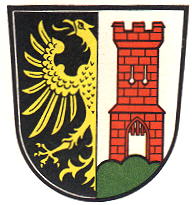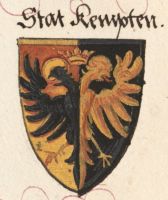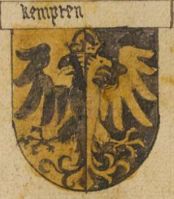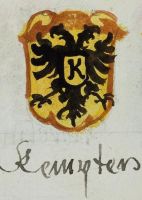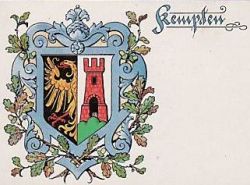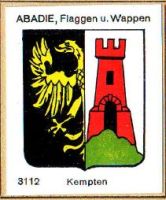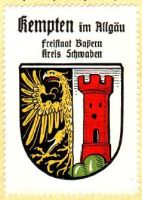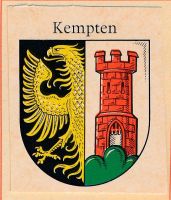Kempten: Difference between revisions
Knorrepoes (talk | contribs) m (Text replacement - "{{de}}" to "") |
Knorrepoes (talk | contribs) m (Text replacement - "|'''English''' ↵| {{blazon wanted}}↵" to "|'''English''' | blazon wanted ") |
||
| Line 16: | Line 16: | ||
|- | |- | ||
|'''English''' | |'''English''' | ||
| | | blazon wanted | ||
|} | |} | ||
Revision as of 09:52, 7 April 2023
KEMPTEN
State : Bayern
Urban district (Stadtkreis) : Kempten
Additions : 1972 Sankt Lorenz, Sankt Mang
| German | Gespalten; von Schwarz und Silber; vorne am Spalt ein halber goldener Adler, hinten auf grünem Dreiberg ein roter Zinnenturm mit offenem Tor. |
| English | blazon wanted |
Origin/meaning
The arms were officially granted on December 12, 1488 and confirmed on January 5, 1819.
Kempten was an Imperial city in medieval times and thus entitled to use the imperial eagle in its arms and seals. The oldest seals, however do not show the eagle. The oldest seal dates from the early 14th century and shows the patron saint of the city at the time, St. Gordianus. Later sources indicate that the shield was horizontally divided from silver and blue. The second seal dates from 1403 and shows St. Hildegard, who was combined with the arms in a later 15th century seal.
In 1488 Emperor Friedrich III granted the city new arms, a vertically divided shield gold and black, with the imperial eagle in the opposite colours.
In the late 16th century the city started to use the symbols used on the local coins, an eagle with the letter K on its breast. These arms were used until 1819.
In 1818 the city was combined with the Imperial Abbey Kempten and the new arms showed the imperial eagle from the city arms, and a tower taken from the arms of the Abbey.
Arms of Kempten]]
The arms in a 16th century manuscriptThe arms in an album from around 1910
Arms (crest) of Kempten]]
The arms in the Abadie albumsWappen von Kempten]]
The arms by Hupp in the Kaffee Hag albums +/- 1925The arms in an album from 1968
Literature: Stadler, 1964-1971, 8 volumes.
